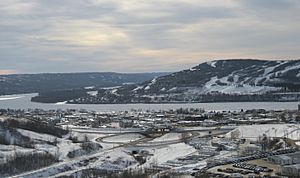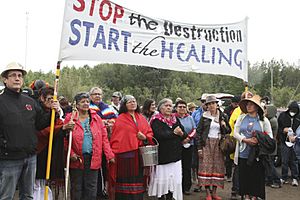Melina Laboucan-Massimo facts for kids
Quick facts for kids
Melina Laboucan-Massimo
|
|
|---|---|
| Born | 1981 (age 43–44) Peace River, Alberta, Canada
|
| Nationality | Cree, Canadian |
| Education | University of Victoria (MA) University of Alberta (BA) |
| Organization | Sacred Earth Solar, Indigenous Climate Action |
| Honours | David Suzuki Fellowship (2017) |
Melina Laboucan-Massimo (born 1981) is a strong voice for climate justice and Indigenous rights. She comes from the Lubicon Cree community of Little Buffalo in northern Alberta, Canada.
Growing up, Melina saw firsthand how oil and gas drilling affected her community. She first spoke out against taking resources from Indigenous lands. But after a big oil spill near Little Buffalo in 2011, she changed her focus. She started working to support a shift to clean, renewable energy.
Melina used to work for Greenpeace. She also started Sacred Earth Solar and co-founded Indigenous Climate Action. These groups help lead clean energy and climate projects run by Indigenous people in Canada. From 2010 to 2014, she helped organize the yearly Tar Sands Healing Walk in Alberta. In 2015, she helped build a large solar panel system. This system now powers the local health centre in Little Buffalo. She is also a Fellow at the David Suzuki Foundation. Her TV show, Power to the People, highlights renewable energy projects by Indigenous communities across Canada.
Early Life and Learning

Melina Laboucan-Massimo was born in 1981 in Peace River, Alberta. Her father was Cree and her mother was Italian. Melina grew up in Little Buffalo. She is a member of the Lubicon Cree First Nation.
In 1988, her community protested for six days. They were upset about how oil and gas drilling was affecting their land. This experience made Melina interested in speaking up for what is right. As a young person, she began to advocate for an end to resource extraction on Indigenous lands. She was worried about the harm to the environment and their culture.
In 2002, Melina was part of the City of Edmonton Youth Council. She earned a Bachelor's degree in Sociology from the University of Alberta. During her studies, she became interested in Spanish literature and Latin American history. She especially focused on the struggles of Indigenous peoples in Latin America.
She also did an internship through the Canadian International Development Agency. Her work involved helping to create a teaching method. This method helped students connect with each other and learn about different cultures. After her degree, she traveled to Brazil, Mexico, and Australia for various jobs. Later, she moved to British Columbia to work with Redwire Magazine, which focused on Indigenous issues.
In 2009, Melina was studying for her Master's degree in Environmental Studies at York University. But she took a break when her mother became sick. Melina believed her mother's illness might be linked to living near the Alberta oil sands. This inspired her to move home and find more ways to work for environmental protection.
Standing Up for Change
Melina Laboucan-Massimo joined Greenpeace as a full-time campaigner in 2009. The next year, she helped start the Tar Sands Healing Walk. This was a prayer walk and protest against the effects of oil and gas drilling in Alberta. It happened every year from 2010 to 2014.
When Greenpeace launched its ship Rainbow Warrior III in 2011, Melina performed a special blessing. She used a Cree prayer and ceremony for the ship.
On April 29, 2011, a pipeline broke near Little Buffalo. About 4.5 million litres of oil spilled. This was Alberta's biggest oil leak in forty years. After this oil spill, Melina's work changed. She focused on directly supporting a shift to renewable energy. She created a photo essay with Greenpeace to show the oil spill's effects. In March 2012, she spoke to a committee in the United States. She argued against building the Keystone XL pipeline.
In July 2013, Melina's younger sister, Bella, passed away. Bella's death led Melina to join calls for a national inquiry into missing and murdered Indigenous women in Canada. She pushed for an inquiry process that was more effective and created by the families affected. A national inquiry finally began in late 2015.
Melina finished her Master's degree in Indigenous Governance from the University of Victoria. She focused on renewable energy. In 2015, as part of her degree project, she helped build a 20.8-kilowatt solar panel system. This system now powers the local health centre in Little Buffalo.
In 2015, Melina started Sacred Earth Solar. This group supports solar energy projects led by Indigenous people across Canada. She also co-founded Indigenous Climate Action. This organization works for climate change solutions led by Indigenous communities. She has supported Secwépemc activists protesting the Trans Mountain pipeline expansion. She provided solar panels to power their tiny houses. These houses were built along the pipeline route to protect Secwépemc traditional land rights.
In 2017, Melina received the David Suzuki Fellowship. This award supports scientific research that offers solutions and inspires community action. She used the grant and mentorship to expand her research on renewable energy. In 2019, Melina became the "just transition" director for Indigenous Climate Action. As of 2021, she was on the board of Seeding Sovereignty and NDN Collective. She was also on the steering committee of the Indigenous Clean Energy Social Enterprise.
Media Appearances
Melina Laboucan-Massimo has appeared in several documentaries. These include Revolution (2012), Beyond Crisis (2017), and The Condor & The Eagle (2019).
In late 2019, Melina's own documentary series, Power to the People, aired on the Aboriginal Peoples Television Network. In its thirteen episodes, she showed many different renewable energy projects. These projects were organized by Indigenous communities all across Canada.


